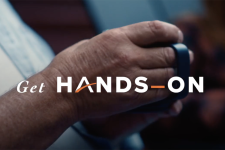
Endo embarks on Steve’s Journey in branded Xiaflex campaign
Months after reupping its Dupuytren’s contracture awareness efforts with Pro Football Hall of Famer John Elway, Endo has launched its first branded TV commercial.
Just over a week ago, the Pennsylvania-based drugmaker unveiled a branded campaign for Xiaflex, its treatment for the progressive hand condition that affects around 17 million Americans.
The 60-second spot is airing during a variety of programming, according to the company, including news programs, sports broadcasts like NASCAR and NCAA basketball as well as TV series like Survivor and Matlock.
The ad is running across a number of cable channels like History Channel and Discovery, as well as on streaming services like Hulu and Amazon, and online sites.
The campaign’s TV spot centers around Steve, a patient living with Dupuytren’s contracture, which limits his hand mobility.
“I miss holding my wife’s hand, so I was very excited to hear about Xiaflex,” said Steve in the brand’s minutelong TV spot.
The ad highlights how the incurable hand condition caused by a buildup of collagen limits the mobility of fingers and can impede everyday tasks.
As Steve closed out the TV spot, he expressed his gratitude for having access to the drug.
“With Xiaflex, I was able to go back to doing the things I was able to do before,” he said.
While 17 million are estimated to have some form of the condition, only 2.5 million people have been properly diagnosed or treated. This delay in receiving an accurate diagnosis can hamper patient care in the interim period.
Additionally, many who seek treatment are often referred for surgery when other treatment options are available, according to Dayna Sracic, Endo’s executive director of consumer marketing.
She said that this branded campaign is intended to empower people with the disease to ask their doctors about Xiaflex and what it could mean for their care journey.
“Our goal is to introduce Xiaflex by name to patients, whereas previous campaigns were aimed at raising awareness about the disease,” said Sracic.
Offered as an alternative to surgery, Xiaflex can be administered in a doctor’s office in under 30 minutes, with patients typically seeing results one to two days later.
So far, approximately 250,000 people have been prescribed the treatment, according to Sracic.
However, many who contract the disease are still offered surgical options from hand specialists, which is expensive and has a longer healing time.
Sracic said introducing the brand name to patients can increase their chances of getting the treatment and avoiding a costly, time-consuming medical procedure.
“Our market research has found that patients are more likely to get a specific treatment if they ask for [Xiaflex],” she said.
Endo has also underscored the widespread coverage of the treatment, noting that Xiaflex is covered by most insurance companies and 90% of patients typically pay no out of pocket costs for it.
In addition to the TV spot, Sracic said Endo developed a tool for the campaign’s website — handonlife.com — where patients can locate hand specialists who have experience with Xiaflex.
She stressed that the company considers its treatment to be a “better alternative” to surgery and reiterated that Xiaflex could be used multiple times to treat various symptoms if the condition progresses.
This echoes the experience of Elway, its lead brand ambassador, who previously partnered with Endo to raise awareness about Dupuytren’s contracture.
Elway, who has been vocal about living with the disease, was administered Xiaflex about five years ago.
“I don’t partner with many companies and brands, but I believe in this procedure and want to share my personal perspective with the people,” Elway stated as part of his latest campaign with Endo last year.
He also noted during that campaign that he was thinking about getting the treatment administered again as one of his fingers where he sensed a lack of mobility.



